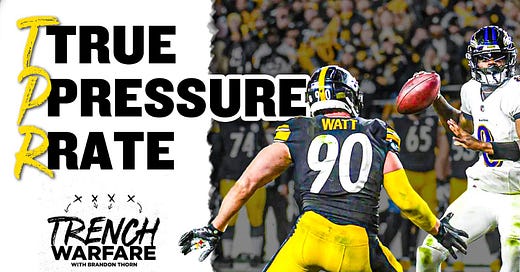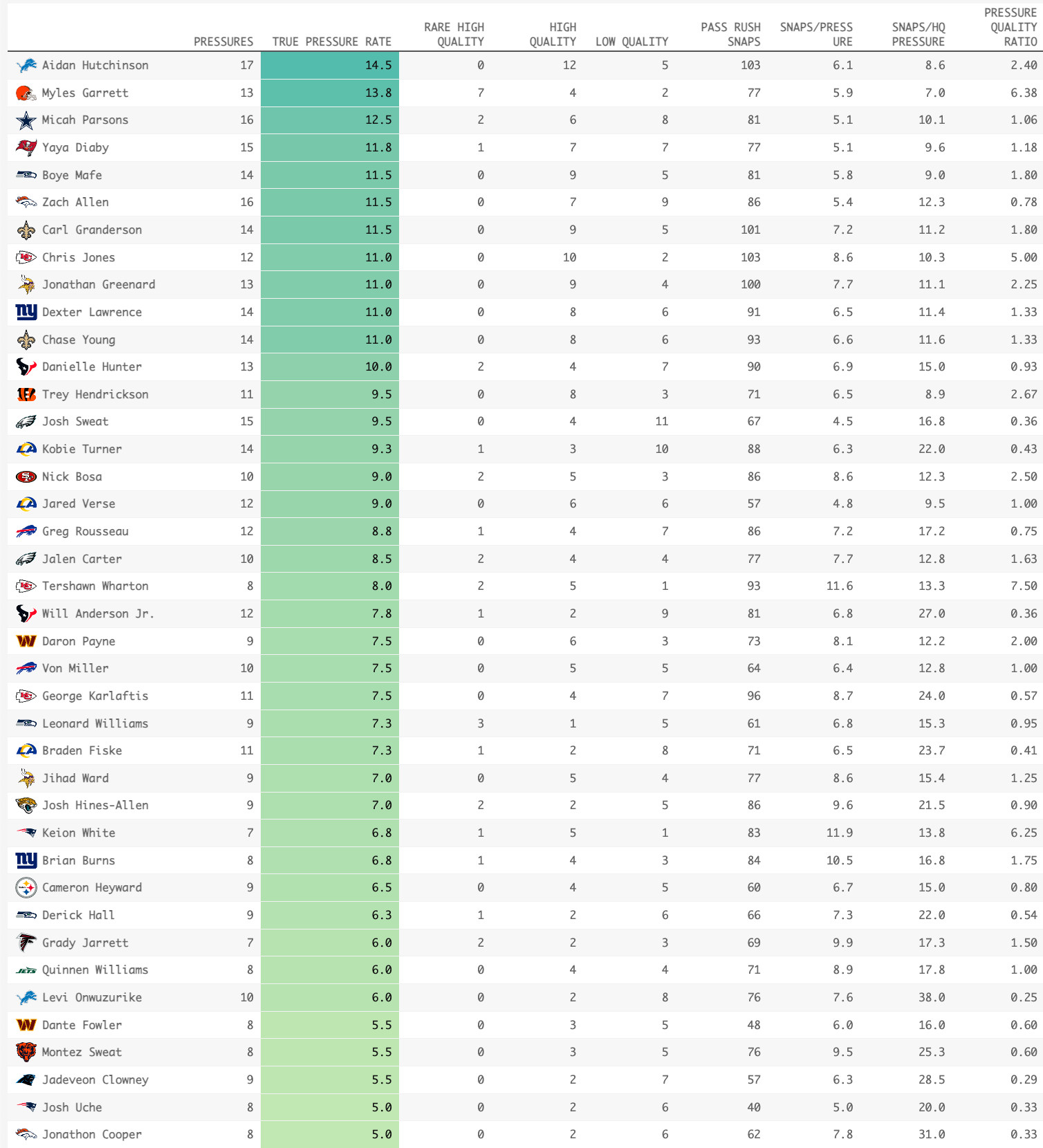True Pressure Rate (TPR): Week 3 Update
Studying, charting and grading every recorded pressure from rushers with nine or more pressures to bring added context to the raw numbers
Welcome everyone to the Week 3 update of the True Pressure Rate (TPR), a complementary evaluation tool to pair with the TSR to bring much-needed context to the ‘sack’ and ‘pressure’ statistics while simultaneously providing a more refined gauge on determining who actually are the most skilled, impactful and valuable pass-rushers in football. This is the first update of the season and this metric will be updated every 2-3 weeks for the duration of the regular season.
From a team perspective, all pressures are positive for a defense, but they can mean very different things for an individual pass-rusher making the play. Player evaluation based on raw pressures often paints an incomplete picture.
A pressure is compiled by most companies (including PFF) as the sum of QB hits/knockdowns, hurries and sacks. Sacks are self-explanatory (tackling the QB at or behind the line of scrimmage), but what are QB hits/knockdowns and hurries?
Per PFF, a QB hurry is defined as, “Forcing a quick throw, flushing the quarterback from the pocket, forcing the quarterback to step up in the pocket, forcing the quarterback to throw a pass away, preventing a quarterback from stepping up into the pocket by collapsing the pocket or preventing the quarterback from stepping into the throw. In the event of the quarterback being forced to step up, the pass rusher absolutely must have beaten the blocker and be past the blocker’s shoulder to be credited with a pressure. If the blocker clearly pushes the defender deep and past the depth of the quarterback’s drop back, then this is not a QB pressure. Multiple defensive players can be credited with a hurry on a given pass play.”
A QB hit is defined as, “Recorded after or as the quarterback releases the pass and a defender hits the quarterback such that the quarterback goes to ground. The quarterback must go down as an action of the defender. Multiple defensive players can be credited with a hit on a given pass play.”
While these definitions sound extremely detailed and theoretically add more nuance and context than sacks do, there is still a grey area.
Take this example from 49ers edge-rusher Nick Bosa from Week 17 of the 2022 season against the Raiders. Bosa was credited with ten QB pressures on the day, but studying each one revealed that number is void of much-needed context.
Here are five of Bosa’s 10 pressures in question. These are simply recorded as ‘pressures’ by PFF, but for the TPR they were recorded as ‘low-quality’ or ‘unblocked’ pressures.
Rep 1 - Low quality pressure: Raiders LT Kolton Miller anchors on Bosa, yet Bosa is still credited with a pressure due to the QB escaping in his direction due to opposite side pressure that collapsed the pocket, forcing the QB to run in his direction.
Rep 2 - Low quality pressure: Bosa’s attempted inside swipe is thwarted by Miller. The QB has to run towards Bosa due to an unblocked blitzer off of the opposite side, creating an opportunity for Bosa to notch a QB hit. Bosa should get some kudos for staying active and using an outside spin to work off of being shut down going inside, but opposite side pressure is the primary reason he was in position to notch a QB hit.
Rep 3 - Unblocked pressure. This one is self-explanatory. Nothing of note was done here from Bosa other than fill space towards the QB.
Rep 4 - Low quality pressure: At first glance Bosa does work past the pulling left guard towards the QB, but the opposite side 3-technique works free through the center of the pocket to force the QB off of his spot, out of the back of the pocket and into Bosa’s path. This is a good example of ‘fortunate circumstances.’
Rep 5 - Unblocked pressure: Bosa gets the QB hit as the unblocked looper on a three-man twist/game. This is a schematic win for the 49ers pass-rush with Bosa merely executing his assignment without demonstrating any special skill or trait.
Now contrast those five LQ pressures with Bosa’s other five pressures, all of which I charted as HQ:
By differentiating and qualifying these different pathways to notching a pressure into three different categories — using film study, charting, and a simple grading scale — we gain valuable insight into which players are earning their production vs. which players are the beneficiaries of fortunate circumstances (like sacks, you’d be surprised just how many ‘pressures’ are the result of fortunate circumstances).
Through this process and combining the results with the TSR, we will be able to more accurately evaluate pressure, sack and overall pass-rush production for the defensive line.
The TPR will provide us with each rusher’s “pressure rate,” based on a point system that specifies three different types of pressures, as outlined below:
1.25 points: Rare High Quality (RHQ) Pressure - A 1-on-1 QB hit or hurry over a very good (Ex: Andrew Thomas) or elite (Ex: Trent Williams) blocker due to the rusher’s skill, move(s) and/or athletic ability.
Example: (2024) Browns DE Myles Garrett beating Giants LT Andrew Thomas using an inside spin move for the pressure and QB hit.
1.0 point: High Quality (HQ) Pressure – A 1-on-1 (or 1-on-2) QB hit or hurry against an above (or below) average blocker due to the rusher’s skill, move(s) and/or athletic ability.
Example (2024): Eagles DT Jalen Carter using his signature inside club move to beat Saints RG Cesar Ruiz for the pressure.
.5 points: Low Quality (LQ) or Unblocked Pressure – A pressure coming as a result of the QB running into the rusher’s direction due to scheme (bootleg, roll-out), pressure from another rusher or being unblocked due to scheme (stunt, twist) or a missed assignment.
Example (2024): Texans edge-rusher Will Anderson Jr. being unblocked with a clear path to the QB
Before we get into the results here are a few notes:
All stats are via TruMedia and PFF
495 pressures from 48 players were charted and graded
Sacks are typically counted in the QB hit category and also into the pressure total for players via TruMedia, but I omitted sacks from these numbers since I already charted/graded those separately for the TSR project. To clarify, the TPR only consists of QB hits/knockdowns (minus sacks) and QB hurries.
While the Pressure Rate accounts for quality, it's heavily affected by volume, so I am introducing another metric called the Pressure Quality Ratio (PQR) that shows the ratio of Rare High Quality + High Quality pressures to Low Quality pressures. While volume is certainly valuable, this helps show why two players with similar total pressures are scored differently, or can help you identify players that may have a lower total volume but are essentially "working harder" for that lower volume. "Working harder" could be due to scheme, attention from offensive personnel, quality of opposing player, etc. In other words, the combination of the pressure score and the pressure quality ratio can level the playing field between players in disparate circumstances. I'd pay attention particularly to outliers in Pressure Quality Ratio.
Top 40 in True Pressure Rate:
*These are total pressures minus sacks (since I will chart those separately for the True Sack Rate)
Top 40 in fewest pass-rush snaps per pressure
Top 40 in fewest pass-rush snaps per HQ pressure
These rushers are the most efficient rushers in the league in terms of their rate of high-quality pressure production
Keep reading with a 7-day free trial
Subscribe to Trench Warfare to keep reading this post and get 7 days of free access to the full post archives.






